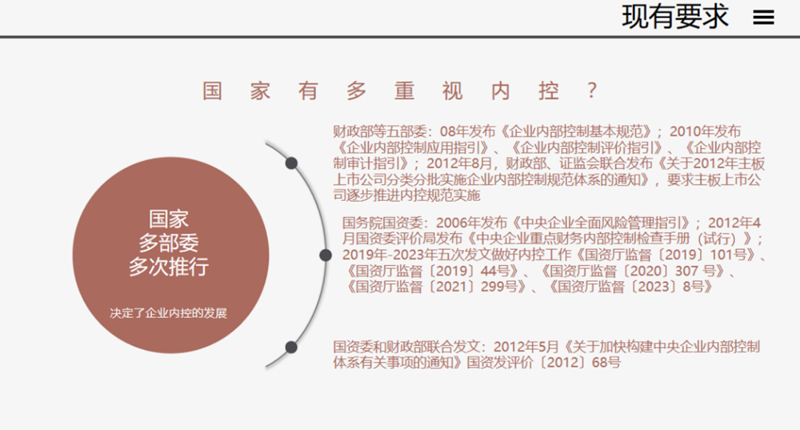
Top
Internal control needs to be integratedall links of enterprise production and operation. The middle and grassroots management personnel of the enterprise must first have proper awareness of internal control. On June 30, 2023, the Internal Control Audit Department of the Company organized an internal control training. All departments (including Lhasa factory) and subsidiaries of the Company participated in this training and exchange, onlineoffline.
During the training, lectures were given by the Internal Control Audit Department of the Company on the history and basic concepts of internal control, national attention, and personnel cooperation in internal control audit.
01 Introduce the major risk of out-of-control internal control and the importance attached by all countries from the important "Enron scandal";
02 Introduce basic concepts from the internal control framework;
03 Introduce the national requirements for internal control in listed companies, the promotion of construction, audit and optimization of the internal control system of listed companies, and the cooperation requirements for employees in internal control audit. The appropriateness principle of "risk management and control" is shared with cost-benefit theory and cases.
How much importance does China attach to internal control? Implemented by multiple national ministries and commissions for many times - determining the development of internal control of enterprises
Five ministries and commissions including the Ministry of Finance issued the Basic Standard for Enterprise Internal Control in 2008 and the Application Guidelines for Enterprise Internal Control, Evaluation Guidelines for Enterprise Internal Control and Audit Guidelines for Enterprise Internal Control in 2010. In August 2012, the Ministry of Finance and China Securities Regulatory Commission jointly issued the Notice on Classified and Batched Implementation of Standard System for Enterprise Internal Control by Main Board Listed Companies in 2012 requiring main board listed companies to gradually establish the standard system for enterprise internal control.
State-owned Assets Supervision and Administration Commission (SASAC) of the State Council issued Guidelines for Comprehensive Risk Management of Central Enterprises in 2006. The evaluation bureau of SASAC issued Inspection Manual on Key Financial Internal Control of Central Enterprises (Trial) in April 2012. From 2019 to 2023, five documents were issued to do a good job in internal control (GZTJD [2019] No. 101, GZTJD [2019] No. 44, GZTJD [2020] No. 307,
GZTJD [2021] No. 299, GZTJD [2023] No. 8).
Notice on Accelerating the Construction of Internal Control System for Central Enterprises (GZFPJ [2012] No. 68) was jointly issued by SASAC and Ministry of Finance in May 2012
Cooperation of all departments
1. Do a good job in the preliminary work, prepare the contents of the data list in advance, and arrange the liaison personnel to provide data in advance (the liaison personnel and contact information of each department can be summarized to form a table and sent to the other party): Provide the specified data on time as required. If the description of the other party is ambiguous, it shall be confirmed with the other party in time (whether to specify the month, sampling for the listall, electronicpaper, whether relevant data are needed);
If the information is confidentialsensitive, the department can communicate with the auditor in time and confirm with the relevant leader; the reasons should also be explained if the information cannot be provided; the information provided should be traceable;
2. Communication: Truthfully reflect the inquiry
3. Confirmation of audit problems: Check the data and evidence from the auditor clearly; provide corresponding certificatesexplanations in case of any misunderstanding; cooperate with the investigation to confirm the cause, impact and rectification if there are indeed problems. Simultaneously, communicate with the auditor for subsequent rectification.

In this training, the Internal Control Audit Department paid more attention to the popularization of basic concepts and examples of internal control, focusing on the importance of internal control and the consequences of out-of-control internal control. The Internal Control Audit Department will strengthen case explanations in subsequent training to explain that small mistakes in internal control will also cause great losses; at the same time, it will continuously answer suspected internal control problems encountered by colleagues in various departments from the perspective of internal control in daily work, coordinate for handling, and further improve the internal control system based on feedback. The training courseware and explanation screen recordings involved in this training will be uploaded to the OA public knowledge area for inquiry and use.